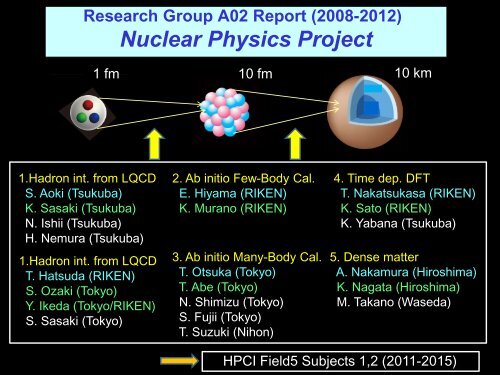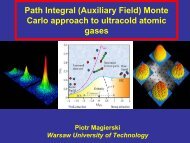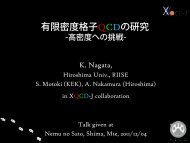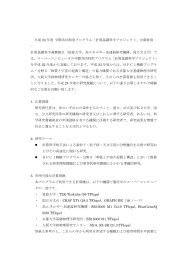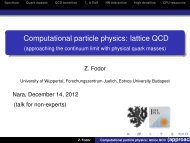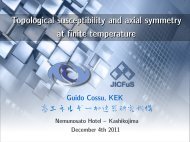Nuclear physics project (A02) report - Joint Institute for ...
Nuclear physics project (A02) report - Joint Institute for ...
Nuclear physics project (A02) report - Joint Institute for ...
You also want an ePaper? Increase the reach of your titles
YUMPU automatically turns print PDFs into web optimized ePapers that Google loves.
Research Group <strong>A02</strong> Report (2008-2012)<br />
<strong>Nuclear</strong> Physics Project<br />
1 fm 10 fm 10 km<br />
1.Hadron int. from LQCD<br />
S. Aoki (Tsukuba)<br />
K. Sasaki (Tsukuba)<br />
N. Ishii (Tsukuba)<br />
H. Nemura (Tsukuba)<br />
1.Hadron int. from LQCD<br />
T. Hatsuda (RIKEN)<br />
S. Ozaki (Tokyo)<br />
Y. Ikeda (Tokyo/RIKEN)<br />
S. Sasaki (Tokyo)<br />
2. Ab initio Few-Body Cal.<br />
E. Hiyama (RIKEN)<br />
K. Murano (RIKEN)<br />
3. Ab initio Many-Body Cal.<br />
T. Otsuka (Tokyo)<br />
T. Abe (Tokyo)<br />
N. Shimizu (Tokyo)<br />
S. Fujii (Tokyo)<br />
T. Suzuki (Nihon)<br />
4. Time dep. DFT<br />
T. Nakatsukasa (RIKEN)<br />
K. Sato (RIKEN)<br />
K. Yabana (Tsukuba)<br />
5. Dense matter<br />
A. Nakamura (Hiroshima)<br />
K. Nagata (Hiroshima)<br />
M. Takano (Waseda)<br />
HPCI Field5 Subjects 1,2 (2011-2015)
Summary of <strong>A02</strong> achievements<br />
Progress of Theoretical and Experimental Physics, (2012) special volume<br />
“Computational Approaches in Particle, <strong>Nuclear</strong> and Astro<strong>physics</strong>”<br />
http://www.ox<strong>for</strong>djournals.org/our_journals/ptep/special_issue_a.html<br />
1. Lattice quantum chromodynamical approach to nuclear <strong>physics</strong><br />
HAL QCD Collaboration, Prog. Theor. Exp. Phys. (2012) 01A105.<br />
2. Gaussian expansion method <strong>for</strong> few-body systems and its applications<br />
to atomic and nuclear <strong>physics</strong><br />
E. Hiyama, Prog. Theor. Exp. Phys. (2012) 01A204<br />
3. New-generation Monte Carlo shell model <strong>for</strong> the K computer era<br />
N. Shimizu et al., Prog. Theor. Exp. Phys. (2012) 01A205<br />
4. Density functional approaches to collective phenomena in nuclei:<br />
Time-dependent density functional theory <strong>for</strong> perturbative and<br />
non-perturbative nuclear dynamics<br />
T. Nakatsukasa, Prog. Theor. Exp. Phys. (2012) 01A207.<br />
5. Towards extremely dense matter on the lattice<br />
XQCD-J Collaboration, Prog. Theor. Exp. Phys. (2012) 01A103.
Basic Strategy of research group <strong>A02</strong><br />
NN<br />
BG/L -> PACS-CS -> T2K -> BG/Q -> KEI<br />
(10TF -> 100TF -> 1PF -> 10PF)<br />
NNN<br />
Nuclei<br />
KEI Computer @ AICS (RIKEN)<br />
(10PFlops)<br />
Supernova explosion<br />
Neutron star merger<br />
YN,YY<br />
YNN<br />
YYN, YYY<br />
J-PARC (KEK/JAEA)<br />
Hypernuclei<br />
Neutron star:<br />
max mass, cooling etc
BB & BBB <strong>for</strong>ce<br />
from lattice QCD<br />
“high precision”<br />
NN interactions<br />
# of<br />
parameters<br />
CD Bonn 38<br />
AV18 40<br />
EFT in N 3 LO 24<br />
QCD has only four parameters :<br />
m u , m d , m s , Λ QCD<br />
HAL QCD method <strong>for</strong><br />
hadron-hadron interactions
BB potentials (flavor SU(3) limit)<br />
Repulsive core in NN channel<br />
IHAL QCD Coll.<br />
Phys. Rev. Lett. 106 (2011) 162002<br />
Nucl. Phys. A881 (2012) 28<br />
1<br />
S 0 channel<br />
3<br />
S 1 – 3 D 1 channel<br />
Attractive core in H channel<br />
Growing NN tensor <strong>for</strong>ce
NN phase shifts (flavor SU(3) limit)<br />
NN<br />
Attraction stonger in the deuteron channel<br />
HAL QCD Coll.,<br />
Phys. Rev. Lett. 106 (2011) 162002<br />
Nucl. Phys. A881 (2012) 28
Highlights (2008-2012) in Lattice <strong>Nuclear</strong> Force<br />
・ basic concepts of the NN ineracition in LQCD<br />
S. Aoki, T. Hatsuda & N. Ishii, PTP 123 (2010) 89<br />
N. Ishii et al. [HAL QCD Coll.], Phys.Lett. B712 (2012) 437<br />
・ central, tensor, LS <strong>for</strong>ces Doi (Fri.), Ishii, Murano (poster)<br />
・ SU(3) BB <strong>for</strong>ce, H-dibaryon & N ☆ Inoue (Fri.)<br />
T. Inoue et al. [HAL QCD Coll.], PRL 106 (2011) 162002<br />
T. Inoue et al. [HAL QCD Coll.], Nucl.Phys. A881 (2012) 28<br />
・ YN and YY <strong>for</strong>ces K. Sasaki, Yamada, Nemura (poster)<br />
H. Nemura et al. [HAL QCD Coll.], Phys.Lett. B673 (2009) 136<br />
・ NNN <strong>for</strong>ce and unified contraction algorithm T. Doi (Fri.)<br />
T. Doi et al. [HAL QCD Coll.], PTP 127 (2012) 723<br />
・ meson-baryon interactions Charron, Ikeda, Ozaki (poster)<br />
T. Kawani and S. Sasaki, Phys. Rev. D82 (2010) 091501 )<br />
LQCD: 96 4 lattice, a=0.1fm, L=9.6fm, m π =135MeV at K cmputer
Ab initio<br />
nuclear few-body<br />
calculations<br />
Gaussian Expansion Method (GEM)<br />
<strong>for</strong> N-body problems (N=3,4,5,…) by E. Hiyama<br />
・ nuclei<br />
・ hypernuclei<br />
・ cold atoms
Summary of progress(FY 2008-2012)<br />
i) Applying Gaussian Expansion Method to N-body problems<br />
N=5 became possible by now<br />
ii) Establishing the following frameworks<br />
・ any interactions such as<br />
central <strong>for</strong>ce, spin-orbit <strong>for</strong>ce, tensor <strong>for</strong>ce,<br />
momentum dependent <strong>for</strong>ce, quadratic spin-orbit <strong>for</strong>ce etc.<br />
・ particle conversion interactions such as<br />
ΛN-ΣN, ΛΛーΞN-ΣΣ etc.<br />
・ bound states, resonant states and continuum states,<br />
simultaneously
We succeeded in<br />
interpreting this<br />
event as an<br />
observation of the<br />
ground state of 11 Be.<br />
ΛΛ<br />
Also, we succeeded<br />
in per<strong>for</strong>ming 5-body<br />
problem.
New data at Jlab in 2012.<br />
E. Hiyama et al., PRC 80,054321(2009).<br />
E. Hiyama and Y. Yamamoto,Prog. Theor.<br />
Phys., 128, 105, (2012).<br />
Inconsistent with the data<br />
p<br />
n<br />
α
Ab initio<br />
nuclear many-body<br />
calculations<br />
Monte Carlo Shell Model (MCSM) by T. Otsuka et al.<br />
・a tool to go beyond the Lanczos<br />
method<br />
・variational wave function +<br />
energy-variance extrapolation<br />
・obtain a few lowest eigenstates<br />
・small I/O, good parallel computation<br />
Intrinsic Density from ab initio calc.<br />
8<br />
Be
Summary of progress(FY 2008-2012)<br />
• Monte Carlo Shell Model<br />
– Methodology developments :<br />
Algorithm development (8 times accelerated)<br />
Y. Utsuno et al., Comp. Phys. Comm. 184 102 (2013).<br />
Energy-variance extrapolation <strong>for</strong> precise estimation of eigenenergies<br />
N. Shimizu et al., Phys. Rev. C 82 061305R (2010), ibid 85 054301(2012).<br />
– Applications:<br />
No-core calculations in light-mass nuclei<br />
T. Abe et al., Phys. Rev. C 86 054301 (2012),<br />
L. Liu et al., Phys. Rev. C 86 014302 (2012)<br />
Shell-model calc. in medium-heavy nuclei<br />
N.B. SPIRE Field 5 launched since FY2011<br />
Neutron-rich Ni, Cr isotopes and shell evolution (Y. Tsunoda et al. ),<br />
Xe, Ba isotopes and shape “phase” transition (N. Shimizu et al. )<br />
Abe (Fri.)<br />
Tsunoda (Fri.)<br />
For review: N. Shimizu, et al. Prog. Theor. Exp. Phys. 2012 01A205 (2012).
Developments of the Monte Carlo shell Model towards “K computer”<br />
PC cluster<br />
100CPU parallel<br />
T. Otsuka, M. Honma, T. Mizusaki, N.<br />
Shimizu, and Y. Utsuno, Prog. Part. Nucl.<br />
Phys. 47, 319 (2001).<br />
N. Shimizu, Y. Utsuno, T. Mizusaki, T. Otsuka, T. Abe,<br />
and M. Honma, Phys. Rev. C 82, 061305(R) (2010).<br />
Precise estimation of energy eigenvalue<br />
by variance extrapolation + reordering technique<br />
Parallel efficiency<br />
N. Shimizu et al., Phys. Rev. C 85<br />
054301(2012).<br />
Improvement of the MCSM<br />
by Conjugate Gradient method<br />
OpenMP+MPI hybrid parallel<br />
N. Shimizu, et al. Prog. Theor. Exp. Phys.<br />
2012 01A205 (2012).<br />
100 CPUs<br />
Algorithm tuning<br />
<strong>for</strong> computation<br />
8 times faster<br />
at maximum<br />
Y. Utsuno, N. Shimizu, T. Otsuka, and T. Abe,<br />
Comp. Phys. Comm. 184 102 (2013).<br />
SPARC64 VIIIfx<br />
705,024 cores
Per<strong>for</strong>mance improvement of the<br />
MCSM code in a single processor<br />
time (sec.)<br />
3.5 times speed up<br />
10 times speed up <strong>for</strong> no-core shell model calc.<br />
@ Xeon 5430 2.2GHz<br />
The per<strong>for</strong>mance improvement owes to the rewritten algorithm.
Time Dependent<br />
Density Functional Theory<br />
Time-dependent Kohn-Sham-Bogoliubov (TDKSB) eq.<br />
by Nakatsukasa and Yabana
<strong>Nuclear</strong> dynamics in the density<br />
functional theory (DFT)<br />
• Developments in new DFT computer codes<br />
– Static DFT<br />
• DFT with the iso-rotational invariance (pn mixing)<br />
– Linear response in TDDFT<br />
• Real-time approach to E1 response<br />
• Systematic calculation of photonuclear reactions<br />
with the finite amplitude method<br />
– Beyond the linear regime<br />
• Shape fluctuation and shape transition with a<br />
microscopically-derived collective Hamiltonian<br />
• Real-time description of fusion dynamics
中 務 原 子 核 理 論 研 究 室<br />
TDDFT description of microscopic nuclear dynamics<br />
Large amplitude shape dynamics<br />
Ebata et al., PRC 82, 034306 (2010);<br />
JPCS 312, 092023 (2011)<br />
Hinohara et al., PRC 82, 064313<br />
(2010) ; PPC 84, 061302(R) (2011)<br />
Sato et al, PRC 86, 024316 (2012)<br />
Shape coexistence phenomena are<br />
being recognized as a kind of<br />
universal feature in nuclei. Quantum<br />
shape fluctuation and mixing are<br />
described by the quantized collective<br />
Hamiltonian obtained through the<br />
TDDFT.<br />
New approach to superfluid nuclear systems<br />
New TDDFT method with time-dependent<br />
pairing dynamics was developed, which reduces<br />
the computational cost by several orders of<br />
magnitude. This may allow a full microscopic<br />
description of nuclear fission in future.
Pygmy dipole states and constraints on symmetry energy<br />
Inakura et al., PRC 80, 044301 (2009); PRC 84, 021302(R) (2011)<br />
Pygmy dipole states are one of typical modes of excitation in<br />
exotic nuclei. We show that they may provide valuable<br />
in<strong>for</strong>mation on the neutron-skin thickness and density<br />
dependence of the symmetry energy.<br />
Proton-neutron-mixing density functional theory<br />
14<br />
O<br />
(ground 0 + )<br />
T<br />
z<br />
(excited 0 + ; T=1)<br />
14<br />
N<br />
=> K. Sato<br />
(Thurs.)<br />
T x<br />
(ground 0 + )<br />
14<br />
C<br />
A computer program of a new nuclear DFT has been<br />
developed based on a “iso-rotational” invariant energy<br />
density functional. This will be further utilized in study the<br />
isoscalar (T=0) pairing and charge-exchange reaction.
<strong>Nuclear</strong> and SN EOS<br />
Variational Method by Takano et al.<br />
・ finite T<br />
・ asymmetric matter
Progress of the Research (2008-2012)<br />
Construction of a nuclear EOS <strong>for</strong> supernovae (SNe)<br />
with the cluster variational method (In progress)<br />
Method<br />
The cluster variational method with AV18+UIX <strong>for</strong> uni<strong>for</strong>m matter.<br />
The Thomas-Fermi method <strong>for</strong> non-uni<strong>for</strong>m matter.<br />
Collaboration with A03-group<br />
Yamamuro, Nakazato, Suzuki<br />
(Tokyo Univ. Sci.)<br />
Numerical calculations of the free energies <strong>for</strong> various densities,<br />
temperature and proton fractions: ~ 10 7 points<br />
Supported by A04-group Matsufuru(KEK)<br />
A part of the energy is calculated with GPU: ~100 times faster!
The SN-EOS with the cluster variational method<br />
Togashi (Fri.)<br />
The free energy of hot asymmetric nuclear matter is calculated<br />
with the method by Schmidt and Pandharipande, toward a SN-EOS.<br />
AM: A. Mukherjee, PRC79(2009)045811.
Variational method with the explicit energy functional<br />
Takano (poster)<br />
Pure Neutron Matter Symmetric <strong>Nuclear</strong> Matter<br />
The v6’ potential (Preliminary)<br />
Reasonable energies are obtained
Dense LQCD
Summary (2008-2012)<br />
• Lattice Study of Finite Density QCD<br />
– Wilson Fermions with improved Gauge and Fermion action<br />
• Fugacity Expansion Formula, 2010<br />
[PRD82,094027(2010)]<br />
– Fermion matrix size reduction (CPU time reduction)<br />
– Useful<br />
• in the Multi-Parameter Reweighting<br />
• to Lee-Yang zeros study<br />
• to calculate higher order Taylor coefficients
Summary continued<br />
• Imaginary Chemical Potential approach,<br />
2011[PRD83,114507(2011)]<br />
– Continuation of the Imaginary chemical potential Phase<br />
Boundary to Real chemical potential<br />
• Equation of State, 2012[JHEP1204,092,(2012) ]<br />
– Comparison of the Multi-Parameter Reweighting and<br />
Taylor Expansion<br />
• Lee-Yang Zeros and Canonical approach,<br />
2012[PTEP01A103(2012)]<br />
• Towards Low Temperature and finite density,2012<br />
– To study Fermion Matrix behavior (eigenvalue behavior) of<br />
the reduction fermion matrix<br />
– To analyze how to take the limit towards Low temperature,<br />
Finite density and Thermo-dynamical state
Highlights (2008-2012)<br />
• Lee-Yang Zero [PTEP01A103(2012)]<br />
– Zeros in Complex Fugacity plane<br />
– Reflects Phase Structure<br />
At low T, two circles (baryon and anti-baryon)<br />
At high T, they merge into one unit circle.<br />
Nagata (Sat.)
Summary of <strong>A02</strong> achievements<br />
Progress of Theoretical and Experimental Physics, (2012) special volume<br />
“Computational Approaches in Particle, <strong>Nuclear</strong> and Astro<strong>physics</strong>”<br />
http://www.ox<strong>for</strong>djournals.org/our_journals/ptep/special_issue_a.html<br />
○ Lattice quantum chromodynamical approach to nuclear <strong>physics</strong><br />
HAL QCD Collaboration, Prog. Theor. Exp. Phys. (2012) 01A105.<br />
○ Towards extremely dense matter on the lattice<br />
XQCD-J Collaboration, Prog. Theor. Exp. Phys. (2012) 01A103.<br />
○ Gaussian expansion method <strong>for</strong> few-body systems and its applications<br />
to atomic and nuclear <strong>physics</strong><br />
E. Hiyama, Prog. Theor. Exp. Phys. (2012) 01A204<br />
○ New-generation Monte Carlo shell model <strong>for</strong> the K computer era<br />
N. Shimizu et al., Prog. Theor. Exp. Phys. (2012) 01A205<br />
○ Density functional approaches to collective phenomena in nuclei:<br />
Time-dependent density functional theory <strong>for</strong> perturbative and<br />
non-perturbative nuclear dynamics<br />
T. Nakatsukasa, Prog. Theor. Exp. Phys. (2012) 01A207.
Advanced <strong>Institute</strong> <strong>for</strong> Computational Science (AICS), RIKEN<br />
10 PFlops supercomputer KEI “ 京 ” (full operation started on Sep.28, 2012)<br />
http://www.aics.riken.jp/en/<br />
Five “strategic” programs (FY 2011-2015)<br />
1. Life and Medicine 2. New Materials 3. Environment<br />
4. Engineering 5. Particle, <strong>Nuclear</strong> and Astro<strong>physics</strong><br />
Project 1: Lattice QCD<br />
Project 3: Supernovae<br />
Project 2: ab initio Nuclei<br />
Project 4: First stars and galaxies<br />
LQCD: 96 4 lattice, a=0.1fm, L=9.6fm, m π =135MeV<br />
Yamazaki (fri.)
Energy-variance extrapolation<br />
Highlights of the MCSM studies<br />
Benchmark calc. in light nuclei<br />
Talk by T. Abe<br />
Level scheme of 68 Ni (a doubly magic nucleus)<br />
Intrinsic Density from ab initio calc.<br />
8<br />
Be<br />
β ~ 0.0<br />
Talk by Y. Tsunoda<br />
β ~ -0.2 β ~ 0.4 (superde<strong>for</strong>med)
List of related works(FY 2008-2012)<br />
• Shape transition in exotic Si & S isotopes, Y. Utsuno, T. Otsuka, B. A. Brown, M. Honma,<br />
T. Mizusaki, and N. Shimizu, Phys.Rev. C86, 051301 (2012)<br />
• VMU in p-shell nuclei C. Yuan, T. Suzuki, T. Otsuka, F. Xu, and N. Tsunoda, Phys. Rev.<br />
C85, 064324 (2012)<br />
• Beta decay <strong>for</strong> astro<strong>physics</strong> T. Suzuki, T. Yoshida, T. Kajino, and T. Otsuka, Phys.Rev. C85,<br />
015802 (2012)<br />
• Renormalization persistency of tensor <strong>for</strong>ce in nuclei, N. Tsunoda, T. Otsuka, K.<br />
Tsukiyama, and M. Hjorth-Jensen, Phys.Rev. C84, 044322 (2011)<br />
• Electron capture from astrophysical interest T. Suzuki, M. Honma, H. Mao, and T.<br />
Otsuka, Phys.Rev. C83, 044619 (2011)<br />
• Novel features of nuclear <strong>for</strong>ces and shell evolution in exotic nuclei, T. Otsuka, T. Suzuki,<br />
M. Honma, Y. Utsuno, N. Tsunoda, K. Tsukiyama, and M. Hjorth-Jensen, Phys. Rev. Lett.<br />
104 , 012501 (2010)<br />
• Three-body <strong>for</strong>ces and the limit of oxygen isotopes, T. Otsuka, T. Suzuki, J. D. Holt, A.<br />
Schwenk, and Y. Akaishi, Phys.Rev.Lett. 105, 032501 (2010)<br />
• Neutrino-induced reaction <strong>for</strong> stellar process T. Suzuki, M. Honma, K. Higashiyama, T.<br />
Yoshida, T. Kajino, T. Otsuka, H. Umeda, and K. Nomoto, Phys.Rev. C79, 061603 (2009)<br />
• Exotic Magnetic Properties in 17 C T. Suzuki, and T. Otsuka, Phys.Rev. C78, 061301 (2008)
Highlights of the MCSM studies I<br />
Energy-variance extrapolation<br />
- precise estimate of<br />
exact eigenvalues -<br />
Talk by T. Abe<br />
Benchmark calc. in light nuclei<br />
- ready <strong>for</strong> systematic calcs. -
Highlights of the MCSM studies II<br />
Level scheme of 68 Ni (a doubly magic nucleus)<br />
Talk by Y. Tsunoda<br />
Intrinsic Density from ab initio calc.<br />
β ~ 0.0<br />
β ~ -0.2 β ~ 0.4 (superde<strong>for</strong>med)<br />
8<br />
Be<br />
three phases within 3 MeV
Highlights continued<br />
Phase of Fermion Determinant<br />
-- The Origin of the Sign Problem<br />
very sever just below Tc<br />
not sever at low T and<br />
At low temperature,<br />
Fermion Determinants are<br />
insensitive to the chemical<br />
potential up to<br />
This corresponds to<br />
(Silver-Blaze phenomena)<br />
This can be understood from Eigen Value<br />
behavior.<br />
[PTEP01A103(2012)]
Variational Method with the Energy Functional<br />
Uni<strong>for</strong>m nuclear matter at zero temperature<br />
The central + tensor <strong>for</strong>ces<br />
Moderately constrained VM<br />
+<br />
All the three-body cluster terms<br />
(M. Takano)<br />
Extension to the spin-orbit <strong>for</strong>ce<br />
v8’ pot. + phenomenological TBF<br />
V6’ pot.<br />
JPS2011<br />
Two-body part: the tensor and spinorbit<br />
correlations are constrained.<br />
Three-body part: tuned so as to<br />
reproduce the saturation point<br />
Further refinement is in progress<br />
NUFRA2011
Progress of the Research (<strong>A02</strong>: Takano)<br />
Extension of the cluster variational method to Λ hyperon matter:<br />
Collaboration with Hiyama (RIKEN: <strong>A02</strong>) In progress<br />
2) Variational method with an explicit energy functional<br />
Poster by Takano<br />
Energy functional <strong>for</strong> nuclear matter with the v6’ potential<br />
Explicit functional of two-body distribution functions<br />
Full minimization<br />
・Necessary conditions on structure functions are guaranteed.<br />
・A main part of the higher-order cluster terms are included.<br />
The results are reasonable as compared with those<br />
with other many-body calculations.<br />
Extensions to the LS <strong>for</strong>ce and three-body <strong>for</strong>ce are in progress.


